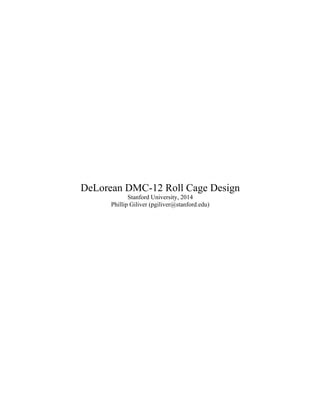
RollCageProposal
- 1. DeLorean DMC-12 Roll Cage Design Stanford University, 2014 Phillip Giliver (pgiliver@stanford.edu)
- 2. Main Design Considerations: Safety: In designing this roll cage, our primary concern was driver safety. All design decisions were made with this in mind, both in terms of chassis-body sturdiness, and also in terms of operational safety. Driver visibility: Given the constrained geometry of the DMC- 12, one of our key considerations was to minimally obstruct the driver's field of view during typical operation (studying oversteer). As such, forward and side visibility is preserved as much as possible, without compromising safety. Driver comfort: As mentioned, the DMC-12 will be used as a research vehicle in the Dynamic Design Lab (DDL) at Stanford University. After accounting for operator and passenger safety, the next-most important consideration is to ensure occupant comfort (ease of entering/exiting the vehicle). Chassis reinforcement: With the new drivetrain installed, we are expecting the vehicle to produce a significant amount of torque on the chassis. While many reinforcement members have been added to strengthen the stock chassis, we expect the new rollcage to provide a bit of chassis rigidity as well.
- 3. Figure 1: Isometric view (top left corner is nearest) Figure 2: Front view
- 4. Figure 3: Side view (driver side) Figure 4: Rear view
- 5. Figure 5: Top view
- 6. Main Hoop Figure 6: Back loop (main hoop) A B C E D Sections A, B, C, D are all in the same plane. This plane is defined as being vertical and passing between the original seatbelt mounting positions (figure 7). Note 1: Gussets that appear in the CAD are not in the PVC mock- up because they were added afterwards. These gussets are easier to see in the top-view of the CAD (figure 5). Note 2: The intersection of bar D and E is incorrectly designated as 90 degrees. The section running from A to the end of E should be as close to the shape of the fiberglass as possible (i.e. the angle between D and E will be >90 degrees).
- 7. Figure 7: Former seatbelt mounting positions (blue arrows) These former seatbelt mounts will serve to mount the main loop. A simple steel plate with a hole will weld to the pipe for each location (4 plates total, 2 per side). Additionally, the intersection of sections C and D (figure 8A) will weld to a steel plate that is bolted through the fiberglass to a steel plate on the chassis.
- 8. Figure 8A: Main Hoop PVC Mock-up C D Note: Section C is welded to section D where it passes over the chassis. Section D is welded to a plate that bolts through to the chassis. Figure 8B: Alternate view of PVC Mock-up
- 9. Front Loop: Figure 9: Front hoop (isometric view) A B Very important design feature: The top bar of the front loop (bar A) is higher than the top bar of the back loop; this was an intentional decision in order to maximize driver visibility. Bar B rests on top of the dash.
- 10. Figure 10: PVC Mock-up of front loop (side view) A B Bar A should be tucked up as high as possible (for driver visibility). A short pipe will run down and have a mitered connection to bar B (see figure 11). Figure 11: CAD Model of front loop (side view)
- 11. Figure 12: PVC Mock-up running along A-pillar
- 12. Side Bars: Figure 13: Side bars (isometric view) C A B Bar A: Connects from A-pillar bar on front loop to back loop. Bar B: Runs along doorsill, behind seat, and mounts into the back loop. Bar C: Bar that runs from chassis mounting point to back loop (same orientation as bar B, except on other side of seat).
- 13. Figure 14A: Outside view of side bar mock-up Figure 14B: Closer look at side bar mock-up
- 14. Figure 14C: View of side bar mock-up from passenger side
- 15. Top Bars / Strut Bars: Figure 15: Top bars, PVC Mock-up The top bars should run along the edges of the fiberglass “T” in the ceiling. As described in the main hoop section, the fronts of these top bars miter to another set of bars which are connected to the front hoop.
- 16. Figure 16A: Strut bars, PVC Mock-up (from inside car) The strut bars should run from the back hoop to the rear strut bar. We were unable to make the bars connect directly into the strut mounts (because we ran into the back window), so we chose to use the strut bar instead. Figure 16B: Strut bar, PVC Mock-up (from behind)
- 17. Figure 16C: Strut bar, PVC Mock-up (closer from behind) If there are any other questions about design decisions we made, feel free to email me (pgiliver@stanford.edu) or call (781-254-5115) during the manufacturing process. If you would like, we can also send CAD files for understanding relative pipe geometries and pipe mounts. Our CAD, while pretty accurate, does not have the exact measurements necessary for making the roll cage. Basically, the closer you guys can get the pipes to fit inside the fiberglass, the better.